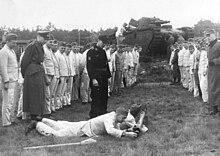Large tractor
United Tractors was the code name of a German tank - prototype , still during the Weimar Republic was developed. Together with the prototypes of the “ light tractor ” developed at the same time, they were the first German armored vehicles to emerge after the First World War .
History and Development
After the First World War, according to the provisions of the Versailles Treaty , the German Reich was prohibited from owning a tank weapon . In order to circumvent this prohibition and the monitoring by the Inter-Allied Control Commission , some armaments companies founded branches abroad. For example, Gutehoffnungshütte acquired the Swedish machine manufacturer Landsverk AB , which later became Sweden's most important tank manufacturer. In Germany itself, the troop office coordinated the previous tank development.
As early as 1926, the Rheinmetall , Daimler-Benz and Krupp companies were commissioned to develop a test tank in the 20-tonne class. All three companies produced two prototypes each from mild steel in 1928 and 1929 , which were given the code name “large tractor” for reasons of secrecy. The vehicles were extensively tested together with the Red Army in the Kama tank school as part of the military cooperation with the Soviet Union (→ Treaty of Rapallo ) .
After the end of the joint German-Soviet cooperation in the course of the takeover of power by the new National Socialist government, the tanks came back to Germany, where they were used as training vehicles in the beginning. Since the still immature prototypes were only partially suitable for this task, they were retired by 1937 and all ended up as memorials to the early tank regiments.
The extensive tests enabled the German designers to gain important experience in tank construction. The construction of the large tractor led directly to the similar-looking new construction vehicle .
technology
The large tractor was designed as a heavy breakthrough car. With its rotating caterpillar tracks , it was very similar to the tank types of the First World War. On the large hull was a fully swiveling turret with a short 7.5 cm cannon - also initially used in Panzerkampfwagen IV . As secondary armament he had three to four machine guns. The vehicles, which weighed around 16 tons, were equipped with various six-cylinder engines from 250 to 260 hp.
literature
- George Forty: The German tank weapon in World War II. Bechtermünz-Verlag, ISBN 3-8289-5327-1 .
- Lars von Rosen: ASJ och Landsverk. Löddeköpinge 2005, ISBN 91-973356-5-7 .
Web links
- Large tractor on achtungpanzer.com (English; with pictures of all prototypes from the three different manufacturers)
